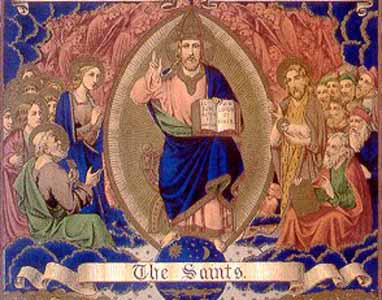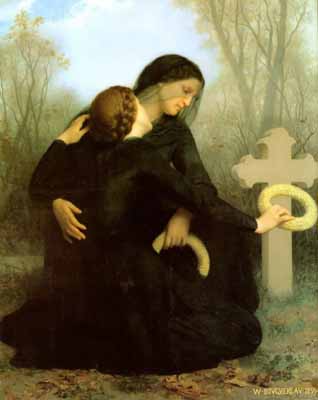

In the Cycles we call Time, souls move from Life to Death to Rebirth. This cycle is said to link with a Judgment Day the balancing of the scales if the soul is to merge with its Twin Flame - to create reunion of the soul's twin aspects separated by the polarity of our reality, the electromagnetic energies that create the magic and illusion.

Ancient Egypt - Afterlife

This was the day of the Celtic New Year.
All Saints' Day, All Hallows, or Hallowmas is a feast celebrated on November 1 in Western Christianity, and on the first Sunday after Pentecost in Eastern Christianity in honour of all the saints, known and unknown. In terms of Roman Catholic theology, the feast commemorates all those who have attained the beatific vision in heaven, while the next day, All Souls' Day, commemorates the departed faithful who have not yet been purified and reached heaven.
In the early Church, Christians would celebrate the anniversary of a martyr's death for Christ (known as the saint's "birth day") by serving an All-Night Vigil, and then celebrating the Eucharist over their tomb or the shrine at their place of martyrdom. In the fourth century, neighbouring dioceses began to transfer relics, and to celebrate the feast days of specific martyrs in common. Frequently, a number of Christians would suffer martyrdom on the same day, which naturally led to a joint commemoration. In the persecution of Diocletian the number of martyrs became so great that a separate day could not be assigned to each. But the Church, feeling that every martyr should be venerated, appointed a common day for all.
A commemoration of "All Martyrs" began to be celebrated as early as the year 270, although no specific month or date are mentioned in existing records. The first trace of a general celebration on a specific day is attested in Antioch on the Sunday after Pentecost. There is mention of a common day in a sermon of St. Ephrem the Syrian (373), and the custom is also referred to in the 74th Homily of St. John Chrysostom (407 AD), who speaks of a "feast of martyrs of the whole world." As early as 411 AF, there is found among the Chaldean Christians a general commemoration of all Confessors (Commemoratio Confessorum), celebrated on the Friday after Easter.
Among the Eastern Orthodox and Eastern Catholics, All Saints Sunday, follows the ancient tradition of commemorating all saints collectively on the first Sunday after Pentecost. The feast of All Saints achieved great prominence in the ninth century, in the reign of the Byzantine Emperor, Leo VI "the Wise" (886-911). His wife, Empress Theophano (commemorated on December 16) lived a devout life. Her husband built a church, intending to dedicate it to her. When he was forbidden to do so, he decided to dedicate it to "All Saints," so that if his wife were one of the righteous, she would also be honored whenever the feast was celebrated. According to tradition, it was Leo who expanded the feast from a commemoration of All Martyrs to a general commemoration of All Saints, whether martyrs or not.
This Sunday marks the close of the Paschal season. To the normal Sunday services are added special scriptural readings and hymns to all the saints (known and unknown) from the Pentecostarion. The Sunday following All Saints Sunday (i.e., the second Sunday after Pentecost) is set aside as a commemoration of all locally venerated saints, such as "All Saints of America", "All Saints of Mount Athos", etc. The third Sunday after Pentecost may be observed for even more localized saints, such as "All Saints of St. Petersburg", or for saints of a particular type, such as "New Martyrs of the Turkish Yoke." In addition to these Sundays, Saturdays throughout the year are days for general commemoration of all saints.
The Western Christian holiday of All Saints Day (called Festum omnium sanctorum in Latin) falls on November 1, followed by All Souls' Day on November 2, and is a Holy Day of Obligation in the Latin Rite Roman Catholic Church, with a vigil. This feast used to have an octave. The octave was abrogated in 1955 along with other octaves.
The origin of the festival of All Saints as celebrated in the West dates to May 13 in 609 or 610 (the day being more important than the year), when Pope Boniface IV consecrated the Pantheon at Rome to the Blessed Virgin and all the martyrs; the feast of the dedicatio Sanctae Mariae ad Martyres has been celebrated at Rome ever since.
The chosen day, May 13, was a pagan observation of great antiquity, the culmination of three days of the Feast of the Lemures, in which were propitiated the malevolent and restless spirits of all the dead. The medieval liturgiologists based the idea that this ">Lemuria festival was the origin of that of All Saints on their identical dates and on the similar theme of all the dead.
The feast of All Saints, on its current date, is traced to the foundation by Pope Gregory III (731-741) of an oratory in St Peter's for the relics "of the holy apostles and of all saints, martyrs and confessors, of all the just made perfect who are at rest throughout the world", with the day moved to November 1. This usually fell within a few weeks of the Celtic pagan holiday of Samhain, which had a theme similar to that of Lemuria, but which was also a harvest festival.
The Irish, whose holiday Samhain had been, did not maintain this November 1 date for All Hallows Day, as extant historical documents attest that the celebration of All Hallows in Ireland took place in the spring: "...the Felire of Oengus and the Martyrology of Tallaght prove that the early medieval churches [in Ireland] celebrated the feast of All Saints upon 20 April." A November festival of all the saints was already widely celebrated on November 1 in the days of Charlemagne. It was made a day of obligation throughout the Frankish empire in 835, by a decree of Louis the Pious, issued "at the instance of Pope Gregory IV and with the assent of all the bishops," which confirmed its celebration on the 1st of November. The octave was added by Pope Sixtus IV (1471-1484).
The festival was retained after the Reformation in the calendar of the Church of England and in many Lutheran churches. In the Lutheran churches, such as the Church of Sweden, it assumes a role of general commemoration of the dead. In the Swedish calendar, the observance takes place on the first Saturday of November. In many Lutheran Churches, it is moved to the first Sunday of November. It is also celebrated by other Protestants of the English tradition, such as the United Church of Canada and the Wesleyan Church.
In the United Methodist Church, All Saint's Day is on the first Sunday in November. It is held to remember all those that have passed away from the local church congregation. A candle is lit by the Acolyte as each person's name is called out. Then, a liturgical prayer is offered for each soul in Heaven.
In Portugal, Spain and Mexico, ofrendas (offerings) are made on this day. In Spain, the play Don Juan Tenorio is traditionally performed. In Belgium, France, Hungary, Italy, Malta, Portugal and Spain people bring flowers to the graves of dead relatives.
In Poland, the Czech Republic, Sweden, Finland, Slovenia, Slovakia, Lithuania, Croatia, Austria, Romania, Hungary and Germany, the tradition is to light candles and visit the graves of deceased relatives. In the Philippines, the day is spent visiting the graves of deceased relatives, where they offer prayers, lay flowers, and light candles.
In English-speaking countries, the festival is traditionally celebrated with the hymn "For All the Saints" by William Walsham How. The most familiar tune for this hymn is Sine Nomine by Ralph Vaughan Williams.

In 1000 A.D. the church made November 2 All Souls' Day, a day to honor the dead. It was celebrated similarly to Samhain, with big bonfires, parades, and dressing up in costumes as saints, angels, and devils.
In Western Christianity, All Souls' Day commemorates the faithful departed. This day is observed in the Roman Catholic Church, churches of the Anglican Communion, Old Catholic Churches, and to some extent among Protestants. The Eastern Orthodox Church observes several All Souls' Days during the year. The Roman Catholic celebration is based on the doctrine that the souls of the faithful which at death have not been cleansed from venial sins, or have not fully atoned for mortal sins, cannot attain the beatific vision in heaven yet, and that they may be helped to do so by prayer and by the sacrifice of the Mass.
All Souls' Day is also known as the Feast of All Souls, Commemoration of all the Faithful Departed (from the Latin Commemoratio omnium Fidelium Defunctorum), Day of the Dead (in Mexico), and Defuncts' Day (in Hungary, France, Italy, and Ecuador).
The Western celebration of the feast falls on November 2 and follows All Saints' Day, which commemorates the departed who have attained the beatific vision. Since the liturgical reforms of the Second Vatican Council the feast is celebrated on November 2 even in years when that date falls on a Sunday. In the traditional Latin rite, the observance is transferred to November 3 if November 2 is a Sunday, as the Mass for the dead and its black vestments is seen as inconsistent with the joyous nature of Sunday. It continues to be transferred in parts of the Anglican Communion.
The Eastern church celebrates several days throughout the year, most falling on Saturdays, because of Jesus' resting in the tomb on Saturday.